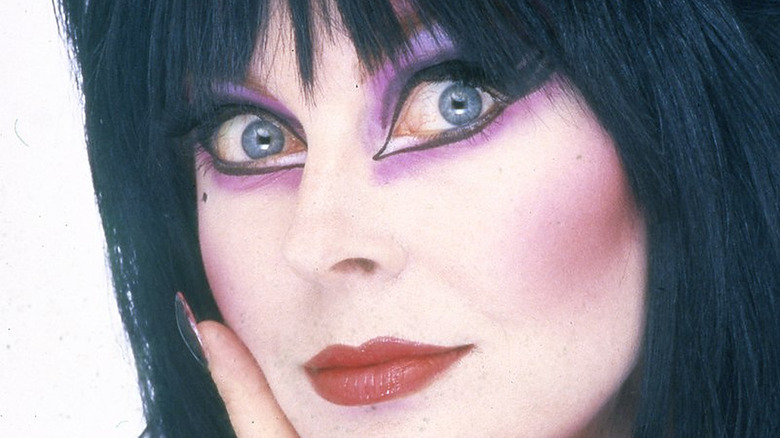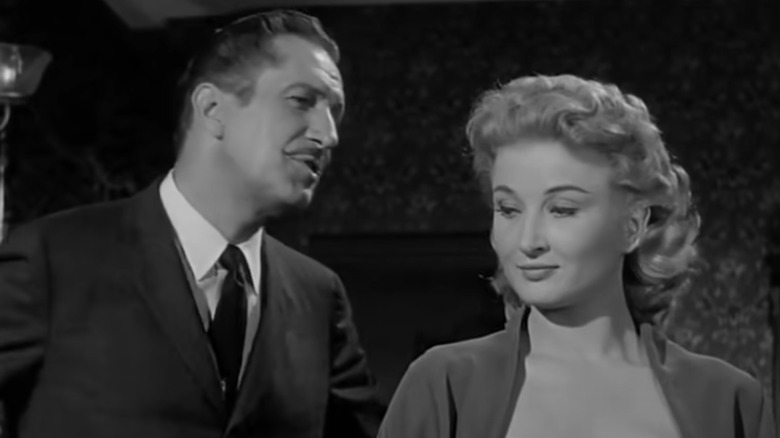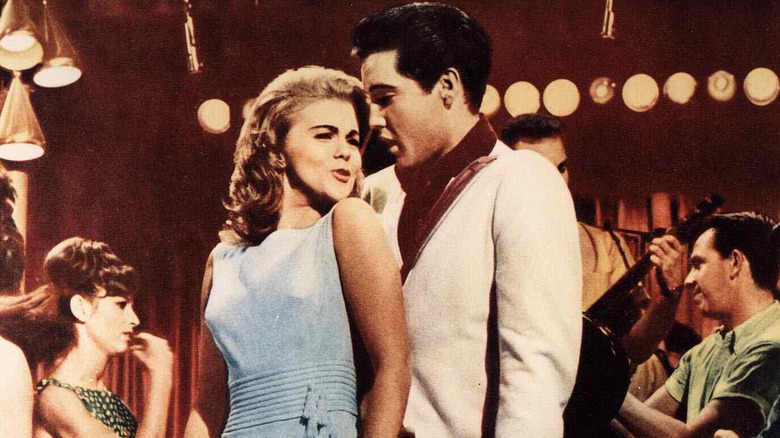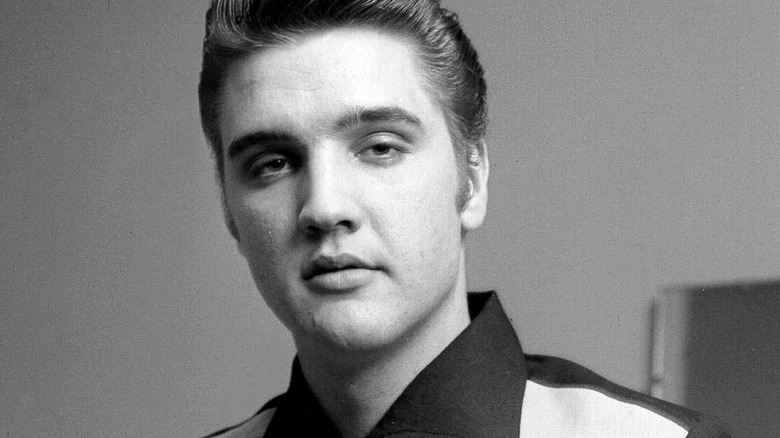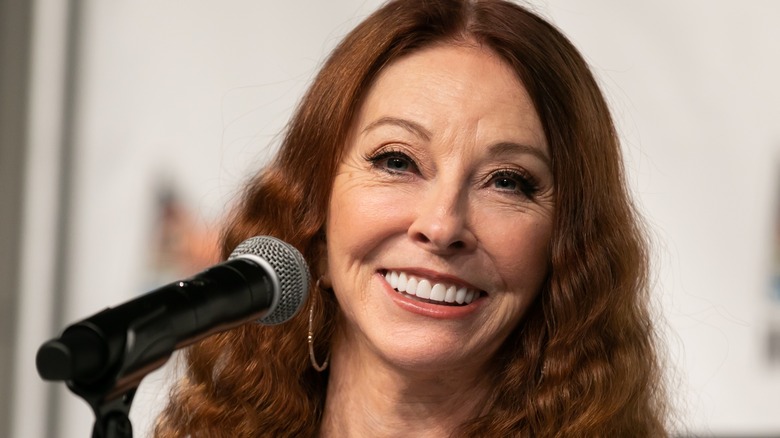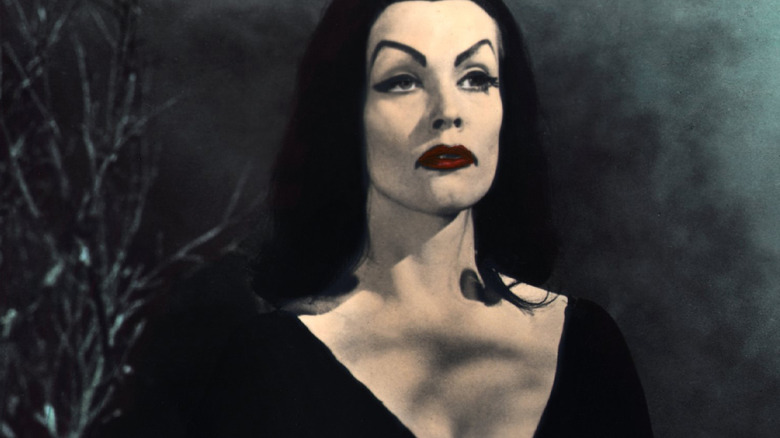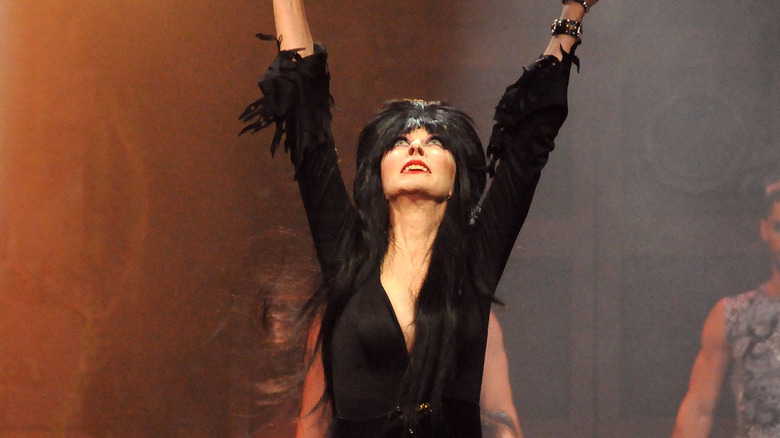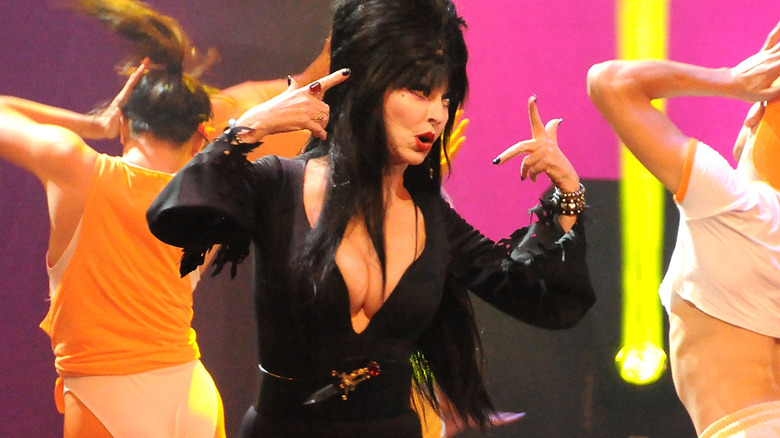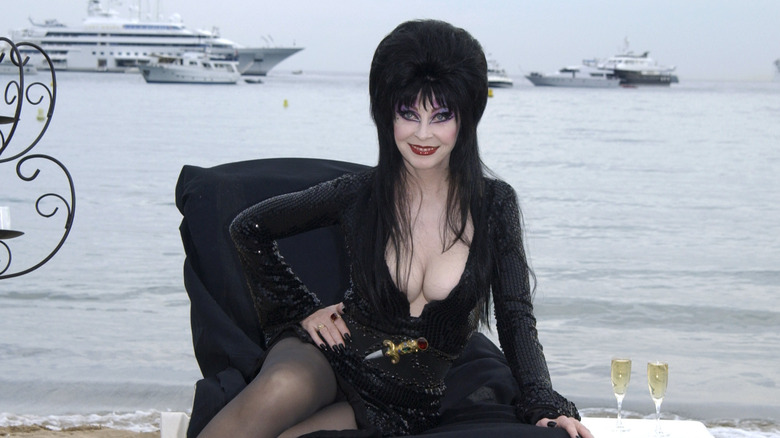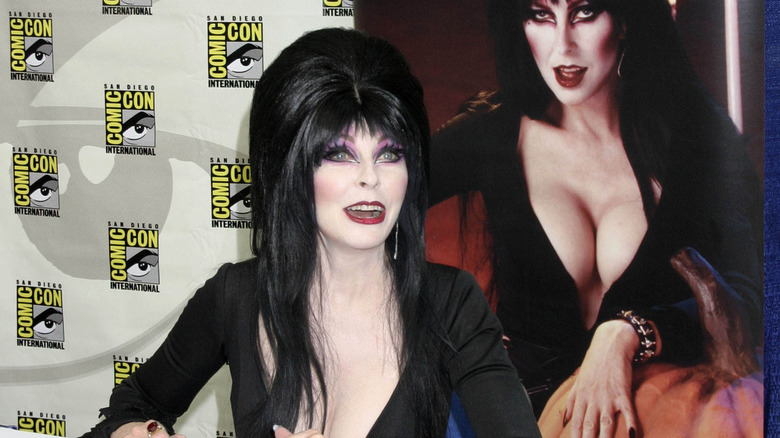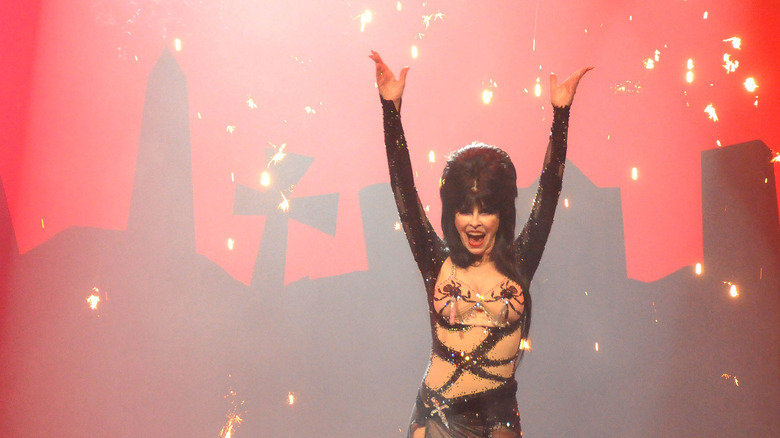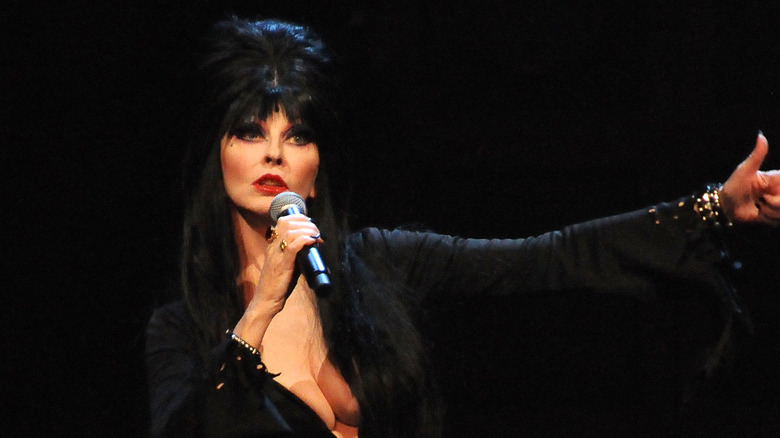Elvira: How She Became Mistress Of The Dark
Elvira is a bubbly, girly, ghoulish horror icon who rose to fame introducing B-movies on local TV and went on to become the undisputed "Mistress of the Dark." With her plunging neckline and slinky black dress, Elvira has become an alternative sex symbol. Larger than life and as funny as she is spooky, Elvira has spanned nearly every element of pop culture, appearing in television, movies, live shows, and seemingly infinite merchandise for decades, as per the Elvira official website.
The woman behind Elvira is performer Cassandra Peterson, who went from a shy and isolated kid to a Las Vegas showgirl before she even turned 18 (via Yahoo). As described in an interview with Vulture, Peterson lived on a farm in Kansas until she was 7, auditioned for modeling gigs as a teenager, and would travel Europe with a pop band before eventually settling in Hollywood where Elvira was born. In an interview Elle Magazine, Peterson said she is responsible for every part of her iconic character, including the makeup, which she does herself every time she transforms into Elvira.
Peterson is still performing as the Mistress of the Dark, particularly around Halloween. She told Vogue, "You may not see me all year, but then in Halloween time, I'm back! That was something I didn't set out to do, but it happened over time. I became the queen of Halloween."
A childhood accident left her with devastating burns
While the character of Elvira seems to radiate confidence, Cassandra Peterson used to be insecure about her appearance due to a childhood accident. When she was only a little over 1 year old, she suffered terrible burns.
Peterson's mother and cousin were coloring Easter eggs. As described in a Yahoo interview with Peterson, her family had the eggs boiling in a large kettle. Peterson climbed up onto a chair and accidentally poured the boiling water all over herself. Her shoulders, neck, back, and legs were extremely burned. Her mother rushed her to the hospital, but the damage was severe. As stated in her autobiography, "Yours Cruelly, Elvira," Peterson lost her hair, her eyelids were fused shut, and her skin was terribly burned.
"Everywhere that [my mother] had to hold on to me, the skin came off ..." Peterson explained to Yahoo. "They didn't think I was going to survive, because 35 percent of my body was third-degree burns."
At a burn center, Peterson received experimental penicillin treatments that saved her life. Over the next several years, she had multiple surgeries and skin grafts treating her scarring.
Horror and Halloween defined her childhood
"I don't know where my confidence came from, because I really suffered most of my life from having no confidence ..." Cassandra Peterson told Yahoo. "I was a really, really shy loner kind of kid, hanging out by myself."
Everything changed when Peterson was 8 years old, she wrote in her memoir, "Yours Cruelly, Elvira," and her cousin took her to see the William Castle film, "House on Haunted HIll," starring horror icon Vincent Price, according to Entertainment Weekly. Afterwards, she had nightmares for a month, and her parents were furious that she'd been taken to such a scary movie. Peterson, however, was hooked. She was soon watching every horror movie she could, especially Hammer films and anything starring Vincent Price.
Peterson had often felt isolated as a child, but through horror, she found a way to embrace what was different about herself. While her siblings played with dolls, young Cassandra Peterson collected figurines of Universal monsters like Dracula and the Mummy, which she painted herself. In a BUILD interview with Ricky Camilleri (via Matt Baume), Peterson explained that her mother owned a costume shop, and as a child she would borrow creepy costumes to wear to school year-round.
She was a Vegas showgirl before she was 18
"House on Haunted Hill" wasn't the only movie that had a profound impact on Cassandra Peterson's life. In an interview with Vulture, she described how seeing Ann-Margret playing a showgirl in "Viva Las Vegas" had inspired her to want to become a showgirl herself. At 17, her family took her and her siblings on a trip and visited Las Vegas, and she convinced them to take her to a show called "Vive Les Girls," even though she wasn't technically old enough to attend. She dressed up, trying to look older in a push-up bra and makeup, which caught the attention of someone who worked at the show. They invited her to audition.
Peterson excelled in her audition and was hired on the spot. She confessed that she was underage, but they still wanted her in the show. Her parents had to legally give their permission by signing a document with a lawyer, but she was allowed to be in the show, even though she wasn't technically old enough to attend.
"I wasn't able to enter the hotel, except through the back through the kitchen," Peterson explained. "I couldn't drink or gamble or go in the casino, but I could dance in a G-string onstage. Very, very strange."
Elvis convinced her to change her career
"Viva Las Vegas" was the movie that had inspired Cassandra Peterson to become a showgirl in the first place — and it also happened to star Elvis Presley. As a teenager, she had a major crush on Elvis, and as a showgirl in Las Vegas, she was able to meet him. As Peterson explained in an interview with Vulture, Elvis came to see her performance, and afterwards, the two hung out, where he gave her some life changing advice.
Elvis played the piano while Peterson sang, and afterwards, he told her that she had talent and suggested that she get singing lessons and pursue her career outside of Vegas. "He actually convinced me that I shouldn't be in Vegas, and that it wasn't a good place for a young girl and that I should get the hell out of there as quickly as I could," she said.
At first, Peterson was disappointed, because she had always dreamed of being a showgirl, but because the advice came from her teen idol, she took what he had to say seriously. When her contract with the show expired, she left Vegas.
Her classic persona came from improv
While Elvira has been called "Mistress of the Dark" and "Queen of Halloween," she is not all doom and gloom. One of the things that has always drawn fans to Elvira is her bubbly, girly personality and ditzy sense of humor. Before she was a Gothic queen, Elvira was a valley girl.
After leaving her job as a Las Vegas showgirl, Cassandra Peterson had to travel in order to find work in show business. For a while, she toured the United States and Europe singing with a rock band, as described in the Los Angeles Times, but what she really wanted to do was comedy. She moved to Los Angeles and dedicated herself to auditioning for roles and doing other small jobs, anything to get by, as she explained to Vulture. It wasn't long before she joined the now-famous improv group The Groundlings and began working on characters, as per the Times. One of those characters would someday be the basis for her beloved persona Elvira.
"My character was unique in that she had a heavy 'valley girl' accent," Peterson explained in her book, "Yours Cruelly, Elvira: Memoirs of the Mistress of the Dark," "something that had only recently been made popular by Frank Zappa and his daughter, Moon Unit, in the song of the same name."
She was originally hired to be Vampira
In the 1950s, Maila Nurmi went to a Halloween party dressed as Morticia from the Addams Family. As told by Dread Central, she was spotted by a producer who recruited her to introduce the horror films the TV station he worked for was running. Nurmi became the first horror host: Vampira. According to the Associated Press, in 1981, a new B-movie horror series was being planned by KHJ-TV that was supposed to be a reboot of "The Vampira Show." Nurmi still had the rights to her character, but she didn't want to reprise it herself. The network wanted Cassandra Peterson to be the next Vampira. Nurmi didn't.
Nurmi already had a replacement in mind for the next Vampira: Lola Falana. As described in "Notable Black American Women," by Jessie Carney Smith, Falana was a singer and actress with famous sex appeal. She had been a massive success as a nightclub performer in Las Vegas. While Falana seemed perfect for the role of Vampira, the network rejected her and cast Peterson without Nurmi's permission. Peterson had responded to an open casting call, according to her book, "Yours Cruelly, Elvira," and wasn't responsible for the network's decision to reject Falana, but the resentment between horror's queens ran deep, and Nurmi even attempted to sue Peterson for copying her character in 1988. Nurmi is quoted by the AP as declaring, "There is no Elvira. There's only a pirated Vampira."
The Elvira character was created at the last minute
On the first day of shooting, Cassandra Peterson was still supposed to be playing Vampira. As recounted in Peterson's memoir, "Yours Cruelly, Elvira," just as they were about to shoot the show's intro, they received a call from Maila Nurmi's lawyer: They weren't allowed to use Vampira. Fortunately, Peterson had already been working on her valley girl character and was ready to transform her into the Queen of Halloween.
In an interview with Dread Central, Peterson admitted that the name "Elvira" was chosen almost at random. It was put into a hat along with other suggestions (including Cassandra and Luna), and Elvira was chosen completely by chance. The initial design that Peterson and her close friend costume designer Robert Redding came up with also had to change.
"The first sketch [Redding] made was ... a long, flowy, diaphanous gown with pink and white patterns and an empire waist," Peterson told Vogue. "The whole makeup and hair would have been ... long and red, and the makeup would be ... kind of a dead girl look."
As described by Refinery 29, the studio rejected the look, forcing them to dress Elvira in black like Vampira. They designed a look inspired by one Redding had done in drag before, including heavy Kabuki-inspired makeup and the sexiest dress they could get away with.
The first version of the dagger belt came from Macy's
One of the most distinct elements of Elvira's costume, which sets it apart from the designs of earlier Goth icons in slinky black dresses like Vampira and Morticia, is her belt, which is latched with a dagger. As Cassandra Peterson stated in an interview with Vogue, the original belt that Elvira wore wasn't so unique. For the first several years, the belt that Elvira wore was one she had gotten straight off the rack at the department store Macy's.
Robert Redding and Cassandra Peterson went shopping together and picked up a leather belt that was held together in the front with a pin. In 1983, Redding came up with a variation on the original design: a dagger. Peterson explained, "He designed a drawing of a dagger and then we went out and had it cast in metal, and added jewels to it."
The dagger was physically made by A-1 Pleating, a specialized custom belt maker that would go on to make Michael Jackson's gloves.
The Elvira costume always stays the same
Elvira's look may have come together at the last minute after the network insisted that she have black hair and a black dress, but the look has become iconic. As described by Cassandra Peterson in an interview with Vogue, she still performs as Elvira, and she's wearing the exact same style that she had in the 1980s when the character was brand new.
After their initial look was rejected, Peterson's close friend Robert Redding designed Elvira's black dress. The dress has an extremely deep V neckline and a high slit up the leg to highlight Peterson's figure, because the two were hoping that they could boost the ratings of the new show using her sex appeal. While the physical dress that Elvira wore in those first shows is no longer used, every dress that Elvira has ever worn was made using the same pattern that Redding originally made in the '80s.
Cassandra Peterson owns the rights to her character
The original KHJ-TV series, "Elvira's Movie Macabre," was a cult sensation, according to her memoir, "Yours Cruelly, Elvira," and a huge success for the network. Initially, Cassandra Peterson didn't share in the success and was compensated very little. As stated by the Los Angeles Times, the network was able to sell 2.7 million pairs of 3-D glasses for an Elvira special, while Peterson was only paid about $350 for her work. The Elvira look proved to be the perfect opportunity for merchandise, however, and Peterson had the rights to her character.
"I'm very fortunate. I do a lot of conventions where I see a lot of other celebrities ..." Peterson told Los Angeles Magazine. "None of them can sell their merchandise. None of them get anything but a few pennies from whatever action figures or T-shirts they have. I lucked out so much to keep control."
Elvira has remained unchanged throughout the decades because Peterson has been able to maintain control of the character, taking it with her after the end of "Elvira's Movie Macabre" and into an original feature film, pop music cameos, and seemingly endless merch, from T-shirts to cereal.
She became a gay icon
In her memoir, Cassandra Peterson came out, declaring that she had been in a committed relationship with a woman for almost two decades. As quoted by Advocate, Peterson admitted when she first saw her future partner at the gym, she believed that she was a man, who she described as "tan, tattooed, and muscular" and "dark and brooding." When she discovered that the person she was so attracted to was a woman, she wasn't deterred. Although they began as friends, they eventually fell in love and moved in together. They kept their relationship a secret for a long time, fearing that Elvira's fans wouldn't react well -– but many of Elvira's most dedicated fans are a part of the LGBTQ+ community themselves.
Her film, "Elvira: Mistress of the Dark," was a niche cult classic rather than a mainstream success, but despite not having any explicitly gay content, it has always been a hit among LGBTQ+ fans. In an interview with Matt Baume, Elvira's longtime collaborator and underground drag performer Joshua Grannell (known to fans as Peaches Christ) explained the gay community's love of Elvira saying, "We respond to uniqueness, outsider personas very well for obvious reasons. She doesn't fit in with the world ... the Christians hate her. What queer person isn't going to identify with that narrative?"
Elvira became a cult success for misfits
The fact that Elvira radiated confidence in herself even when she didn't look or act like anyone else made her a hit with the LGBTQ+ community and many others who felt like they didn't automatically fit in. Elvira has become an alternative beauty icon, but her sex appeal isn't the only reason that she gained a cult following of adoring fans. According to an interview with Cassandra Peterson in Los Angeles Magazine, the majority of her fans are young girls who admire her for her tough attitude, and how little she cares about what anyone else thinks. According to Peterson, this has particularly resonated with teenagers going through puberty who feel socially isolated or like there's something wrong with them.
"Elvira represents a total misfit ..." Peterson explained. "She's kind of an outcast, but she doesn't care. I think it gives people like that the attitude of, 'I don't have to be so upset about it. I can just go my own way and be who I am.'"
